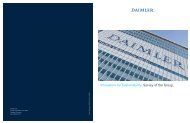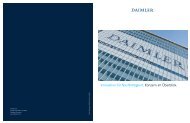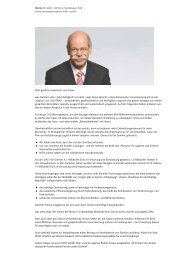Dear readers, This report describes what Daimler means by ...
Dear readers, This report describes what Daimler means by ...
Dear readers, This report describes what Daimler means by ...
Create successful ePaper yourself
Turn your PDF publications into a flip-book with our unique Google optimized e-Paper software.
<strong>Daimler</strong> 360 GRAD - FAKTEN zur Nachhaltigkeit 2008<br />
<strong>Daimler</strong> Nachhaltigkeitsbericht 2008 / Environmental protection, innovation, and safety / Innovation, development and safety /<br />
Sustainable mobility strategy for passenger cars<br />
Sustainable mobility strategy and<br />
implementation for passenger cars<br />
The Group’s long-term strategy for passenger cars involves the consistent further development of economical and<br />
environmentally friendly vehicles that make no sacrifices in terms of safety and comfort. Here, we’re pursuing a<br />
three-stage approach in order to conserve resources throughout the entire value creation process and minimize<br />
pollutant emissions (see chart: “<strong>Daimler</strong>’s road map to sustainable mobility”).<br />
1. Concerted development and optimization of our internal combustion engines.<br />
2. Further enhanced efficiency through hybridization.<br />
3. Emission-free driving with fuell cell and batterypowered vehicles.<br />
The combustion engine and its hybridization will continue to play a key role on the path to zero-emission mobility.<br />
The innovations and technologies that contribute to further reductions in fuel consumption and CO 2 emissions are<br />
summarized below:<br />
� Optimized combustion engines. CGI (stratified charge gasoline injection). Second- generation gasoline direct<br />
injection systems ensure optimal fuel utilization, there<strong>by</strong> generating fuel economy potential. Here, fuel is sprayed<br />
around the spark plugs in the shape of a hollow cone, which enables precise fuel dosages and thus optimized<br />
combustion. For example, as a result of the CGI system the Mercedes-Benz E 350 CGI now consumes 8.7 to 9.2<br />
liters of fuel per 100 kilometers – around 10 percent less than a vehicle equipped with a conventional V6<br />
gasoline engine that operates with duct injection. The CLS 350 CGI, which was introduced in April 2006, was the<br />
world’s first vehicle to feature spray-guided direct injection, a system that was then implemented in 2007 in the E<br />
350 CGI as well. We will begin converting our four-cylinder gasoline engines to this direct injection system in<br />
2009.<br />
DIESOTTO. DIESOTTO is a completely new engine concept from Mercedes-Benz that combines the best features<br />
of diesel and gasoline engines. In particular, it boasts outstanding fuel economy and thus reduced CO 2 emissions<br />
as well as lower nitrogen oxide emissions (NOx). The technology used is based on the principle of operating a<br />
gasoline engine in certain situations with auto ignition, like a diesel. The system also includes CGI gasoline direct<br />
injection combined with turbocharging, variable valve control, a lower number of cylinders, lower displacement,<br />
and an automatic start/stop feature. In 2007, the DIESOTTO engine was presented for the first time in the F 700<br />
research vehicle. The F 700, which is similar in size and appearance to the current S-Class series, achieves fuel<br />
consumption of only 5.3 liters per 100 kilometers, which corresponds to CO 2 emissions of just 127 grams per<br />
kilometer. The core elements of the DIESOTTO concept are now gradually being incorporated into the individual<br />
model series from Mercedes-Benz.<br />
NGT (Natural Gas Technology). Today, natural gas is considered a sensible alternative to conventional drive<br />
system concepts from both an economic and an ecological perspective. Natural gas contains less carbon than<br />
normal gasoline or diesel fuel, for example, and its combustion also produces less pollutant emission. Our NGT<br />
vehicles are equipped with a bivalent drive system that enables them to operate on either natural gas or<br />
premium-grade gasoline. The technology has been available since mid-2004 in the Mercedes-Benz E 200 NGT. A<br />
new model – the B 170 NGT BlueEFFICIENCY – will be launched in the summer of 2008.<br />
� “BlueEFFICIENCY” package. Our “BlueEFFICIENCY” package of innovative measures is based on a holistic<br />
approach to vehicle optimization and the use of intelligent solutions for improving the fuel economy of our<br />
vehicles even further. All of the measures employed are optimally aligned with one another, there<strong>by</strong> resulting in<br />
substantial fuel savings totaling approximately 10 percent. These measures include for example an extended<br />
gear ratio, a lower chassis, extremely low rolling resistance tires, and aerodynamic improvements. The first<br />
BlueEFFICIENCY models – the Mercedes-Benz C 180 Kompressor BlueEFFICIENCY and the C 200 CDI<br />
BlueEFFICIENCY – will be launched on the market in June 2008.














